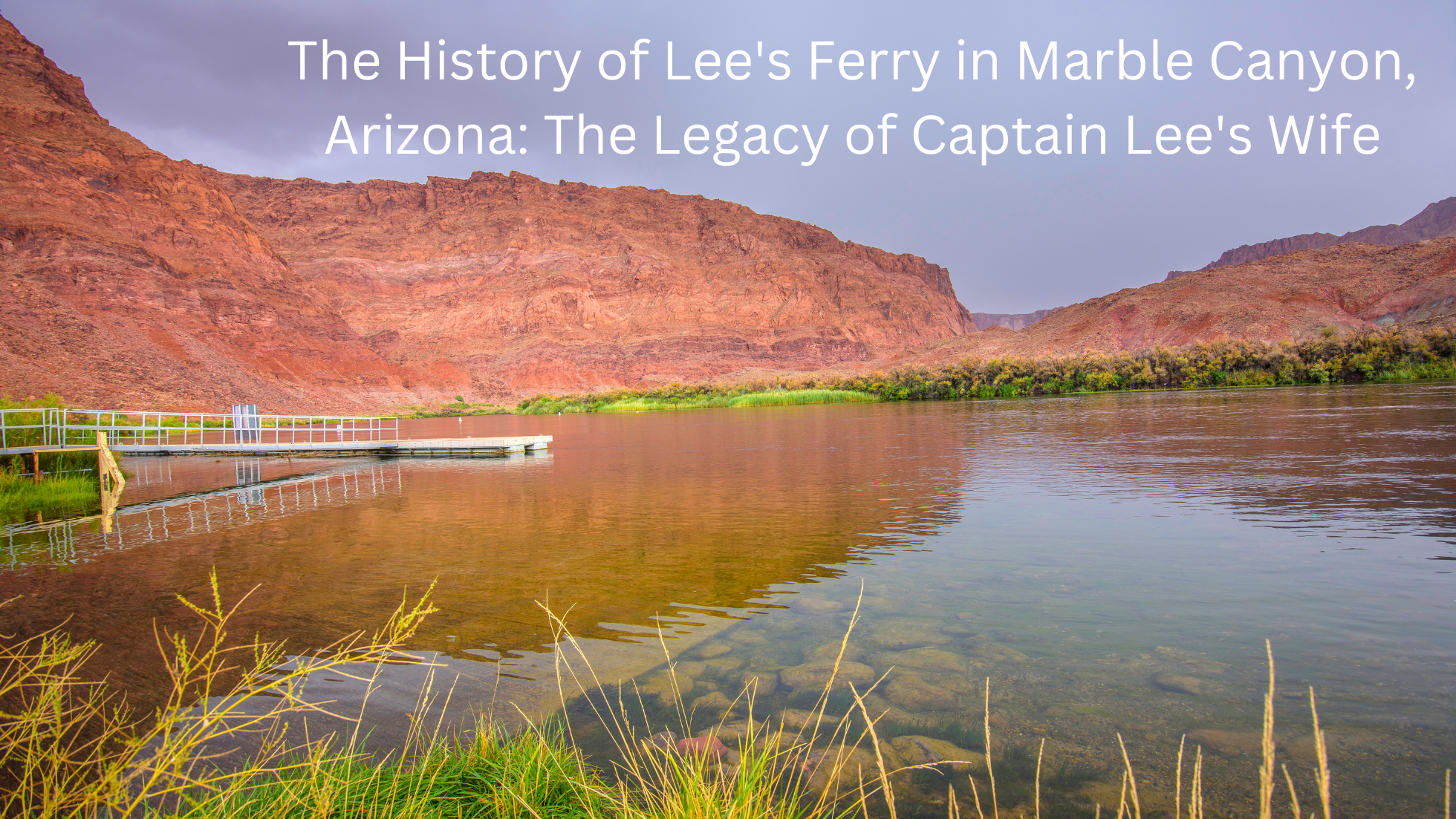Nestled in the rugged landscape of Marble Canyon, Arizona, Lee’s Ferry is a historic site with a rich and intriguing past. It is a testament to the perseverance and determination of early pioneers who navigated the formidable terrain of the American Southwest. This blog will delve into the history of Lee’s Ferry, focusing on the pivotal role of Captain Lee’s wife, Emma, in establishing this crucial crossing point on the Colorado River.
The Early Beginnings
Lee’s Ferry, named after Captain John D. Lee, was established in the late 19th century as a vital crossing point on the Colorado River. Before the Ferry was operational, the Colorado River posed a significant barrier to travelers, settlers, and traders moving between Utah and Arizona. The rugged landscape and swift currents made crossing treacherous, highlighting the need for a safer and more reliable passage.
Captain John D. Lee
Captain John D. Lee, a Mormon pioneer, was tasked with establishing the Ferry in 1872. Lee, a man of many talents and experiences, had previously been involved in various settlements and keenly understood the challenges presented by the harsh environment. His skills and determination made him the ideal candidate for this daunting task. Captain Lees wife, Emma, played a crucial role in the establishment and operation of the Ferry. The partnership between Emma and John D. Lee was instrumental in this endeavor’s success. While John D. Lee focused on the logistics and construction of the Ferry, Emma provided invaluable support, managing the day-to-day operations and ensuring the well-being of their family and those who relied on the Ferry.
The Role of Captain Lee’s Wife
Emma Lee, often called “Captain Lee’s wife,” was more than a supportive spouse. She was a formidable pioneer woman who contributed significantly to the success of Lee’s Ferry. Emma managed the household, tended to travelers, and provided essential services to those who crossed the river. Her resilience and resourcefulness were vital in maintaining the Ferry’s operations in such a remote and challenging environment.
Emma’s role extended beyond the domestic sphere. She was known for her hospitality, often providing food and shelter to weary travelers. Her kindness and generosity left a lasting impression on those who passed through Lee’s Ferry, cementing her legacy as a beloved figure in the area’s history.
The Establishment of the Ferry
Establishing Lee’s Ferry was no small feat. With its unpredictable currents and varying water levels, the Colorado River presented numerous challenges. Captain Lee and his team constructed a sturdy ferry boat capable of withstanding the river’s forces. They also built necessary infrastructure, including a house, storage facilities, and corrals for livestock that is now the location of The Cliff Dwellers Lodge.
The Ferry quickly became a vital crossing point for settlers, miners, and traders. It provided a safer and more reliable means of crossing the Colorado River, facilitating the movement of goods and people between Utah and Arizona. Lee’s Ferry’s success contributed significantly to the development and expansion of the region.
The Importance of Lee’s Ferry
Lee’s Ferry played a crucial role in expanding the American West. It served as a critical link between the northern and southern territories, enabling the flow of commerce and communication. The Ferry was crucial during the gold rush era, as it provided a passage for prospectors and miners seeking fortune in the rich mineral deposits of Arizona.
In addition to its economic significance, Lee’s Ferry was a hub of cultural exchange. It brought together people from diverse backgrounds, fostering community in the remote wilderness. The interactions at the Ferry contributed to the blending of cultures and the sharing of knowledge, enriching the region’s social fabric.
The Decline of the Ferry
The advent of modern transportation and the construction of bridges eventually rendered the Ferry obsolete. In the early 20th century, the construction of the Navajo Bridge located a few miles downstream, provided a more efficient means of crossing the Colorado River. This development marked the end of the Ferry’s operation, but its historical significance remains intact.
Lee’s Ferry Today
Today, Lee’s Ferry Lee’s Ferry is renowned for its exceptional guided fly fishing experiences, attracting anglers worldwide to its pristine waters. Nestled at the base of Marble Canyon, this stretch of the Colorado River is teeming with rainbow trout, offering some of the best fly fishing opportunities in the Southwest. Expert guides at Lee’s Ferry provide invaluable local knowledge, ensuring that novice and experienced fishermen can enjoy a successful and memorable outing. The clear, cold waters and the stunning canyon scenery create a perfect setting for a serene and rewarding fly-fishing adventure. It serves as a gateway to the Glen Canyon National Recreation Area and is the starting point for many Kayaking expeditions.
Visitors to Lee’s Ferry can explore the remnants of the historic site, including the old structures and the ferry crossing. Interpretive signs and exhibits provide insights into the area’s history and significance, offering a glimpse into the lives of the pioneers who once called this place home.
The history of Lee’s Ferry in Marble Canyon, Arizona, is a captivating tale of resilience, determination, and pioneering spirit. Captain John D. Lee and his wife, Emma, played pivotal roles in establishing and operating the Ferry, leaving an indelible mark on the history of the American Southwest. Their legacy and the significance of Lee’s Ferry continue to be celebrated and remembered by those who visit this historic site.
As we reflect on the history of Lee’s Ferry, we are reminded of the enduring human spirit and the remarkable achievements of those who came before us. The story of Captain Lee’s wife, in particular, highlights the often-overlooked contributions of women to shaping our history. Emma Lee’s strength, kindness, and resourcefulness inspire all who learn about her life and legacy.


